Buzz your way into our educationally delightful bee coloring pages. These fun illustrations offer a delightful journey into the mesmerizing world of these essential pollinators, allowing both children and adults to unleash their creativity and bring these tiny wonders to life. From hive scenes to depictions of individual bees, our selection of coloring pages offers a unique opportunity to learn about the fascinating lives of bees while enjoying the therapeutic benefits of coloring.
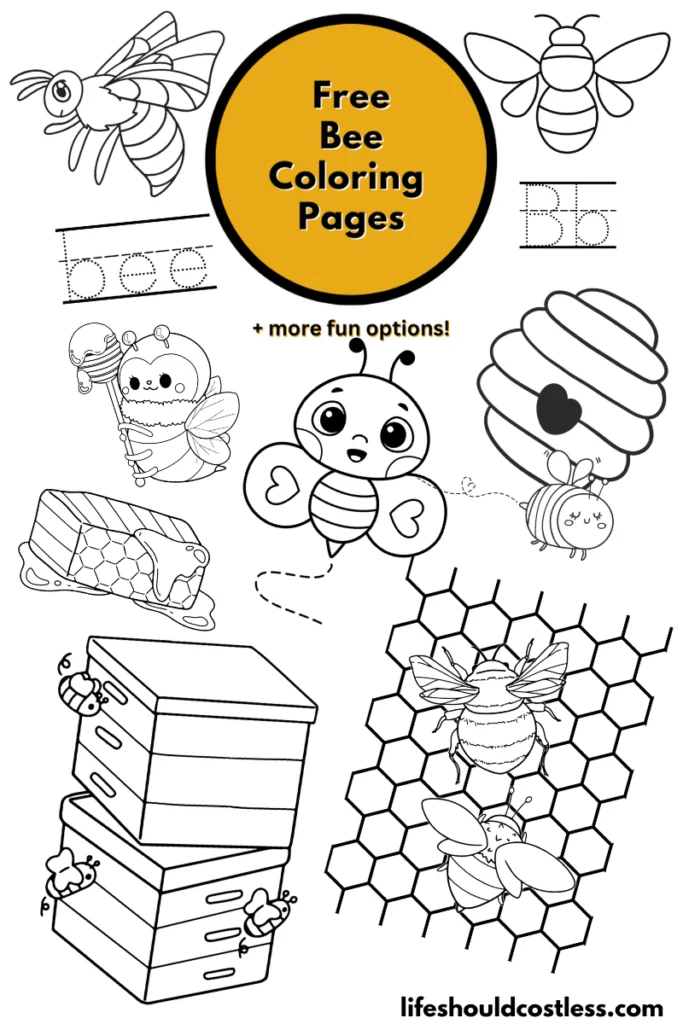
Whether you’re an avid nature enthusiast, an educator seeking engaging resources, or simply looking for a relaxing artistic activity, these bee pictures are sure to captivate your imagination and provide a delightful learning experience for all ages.
Simply choose the design that appeals to you, download the free PDF template, print it, and begin coloring to your heart’s delight.
You can also consider using these designs as embroidery patterns or drawing inspiration for delicate fine-line tattoos.
Bee facts
For those who are unfamiliar with my coloring pages, it’s worth noting that I enjoy offering you the opportunity to not only engage in coloring but also to learn about the subject, effectively transforming the experience into an educational opportunity. So, let’s embark on this journey!
Here are lots of fun and interesting, simplified, facts about bees:
- Incredible Communication: Bees have an astonishing method of communication known as the “waggle dance.” When a forager bee finds a new food source, it returns to the hive and performs a dance that conveys the direction, distance, and quality of the find to other worker bees.
- Astonishing Navigation: Bees have an exceptional ability to navigate. They use the position of the sun and the Earth’s magnetic field as reference points to find their way back to the hive, even after extensive foraging trips.
- Mathematical Prowess: The hexagonal shape of honeycomb cells is not only efficient for storage but also mathematically impressive. It’s been proven that hexagons require the least amount of wax to create and provide the most storage space.
- Diverse Diet: Bees primarily collect nectar and pollen, but their diets can also include other plant secretions, like honeydew, which is produced by aphids.
- A Royal Life: The queen bee has a unique and royal role in the hive. She’s the sole egg layer, and her pheromones regulate the behavior and development of the other bees in the colony.
- Seasonal Survival: During the colder months of the year, worker bees huddle together to create a “winter cluster” within the hive, generating heat by shivering their flight muscles. This cluster helps keep the colony warm and ensures its survival.
- Impeccable Scent Memory: Bees have an exceptional sense of smell. They can remember and distinguish various scents, which is crucial for recognizing different flowers and finding food sources.
- Collective Decision-Making: When a colony becomes overcrowded, some bees will scout for new nesting sites. They return to the hive and perform “dance-offs,” trying to convince the other bees of their chosen location. The final decision is reached through a collective process.
- Short but Busy Life: Worker bees live for about 5 to 6 weeks during the summer months. In this short span, they perform a wide array of tasks, from nursing the young to foraging for food.
- Bee Hairbrushes: Bees have specialized hairs on their legs called “pollen baskets” or “corbiculae.” They use these to collect pollen from flowers and carry it back to the hive.
- Incredible Workforce: A single beehive can house thousands of worker bees, and they collectively visit millions of flowers and travel significant distances to collect nectar and pollen for honey production.
- Nectar to Honey: Bees transform nectar into honey through a process of regurgitation and evaporation. Enzymes in their stomachs break down the nectar’s sugars, and they fan their wings to evaporate excess water, resulting in the thick, golden substance we know as honey.
- Different Dances: The waggle dance is not the only form of communication. Bees also perform a “round dance” to indicate that a food source is nearby but doesn’t require extensive travel.
- Diverse Bee Species: There are over 20,000 known species of bees worldwide, each with its own unique behaviors, preferences, and roles in ecosystems.
- Symbiotic Relationships: Certain flowers have evolved to specifically attract bees for pollination, creating a mutually beneficial relationship where the flowers provide food for the bees, and the bees facilitate plant reproduction.
- Remarkable Strength: Despite their small size, bees are incredibly strong. They can carry loads heavier than their own body weight in pollen and nectar.
- Global Impact: Bees are critical pollinators for many crops that make up a significant portion of the human diet, such as fruits, vegetables, and nuts. Their pollination services are estimated to be worth billions of dollars annually to agriculture worldwide.
- Color Vision: Bees have excellent color vision and can see a wide spectrum of colors, including ultraviolet light. This ability helps them locate nectar-rich flowers that often have unique UV patterns.
- Historical Significance: Honey has been cherished by humans for millennia. Cave paintings from around 8,000 years ago depict people harvesting honey, and it was used as a sweetener and medicine in ancient civilizations.
- Threats to Bee Populations: Bees face numerous challenges, including habitat loss, pesticide exposure, climate change, and diseases. Their declining populations have raised concerns about the potential impact on ecosystems and food security worldwide.
These facts only scratch the surface of the incredible world of bees.
Their behaviors, interactions, and adaptations continue to inspire researchers, artists, and nature enthusiasts alike.
If you would like to continue your knowledge seeking on this subject, here are some other reputable resources to learn about bees while coloring:
- https://en.wikipedia.org/wiki/Bee
- https://www.unep.org/news-and-stories/story/why-bees-are-essential-people-and-planet
- https://thebeeconservancy.org/
- https://www.pbs.org/newshour/science/intelligence-test-shows-bees-can-learn-to-solve-tasks-from-other-bees
- To see all of my free printables, go here.
- If you would like to see my index of free printable coloring pages, go here!
- To see all of my animal coloring pages, go here.
- To see all of my insect-related coloring pages, go here.
Printing instructions
*Keep in mind that while these coloring sheets are free, they are for personal use only. Any additional use will need written permission, from me, obtained via email. Thanks.*

How to get best results with your bee printable
Buzz your way into the educationally informative world of bees with our fun coloring pages. There are free bee printing options for everyone.
Materials
- Black Ink/Toner
- Standard 8.5"x11" Printing Paper (or quality cardstock)
Tools
- Computer/ Phone/ Or Tablet To Download To
- Printer
- Pencil Sharpener
- Colored Pencils
- Eraser (optional)
Instructions
-
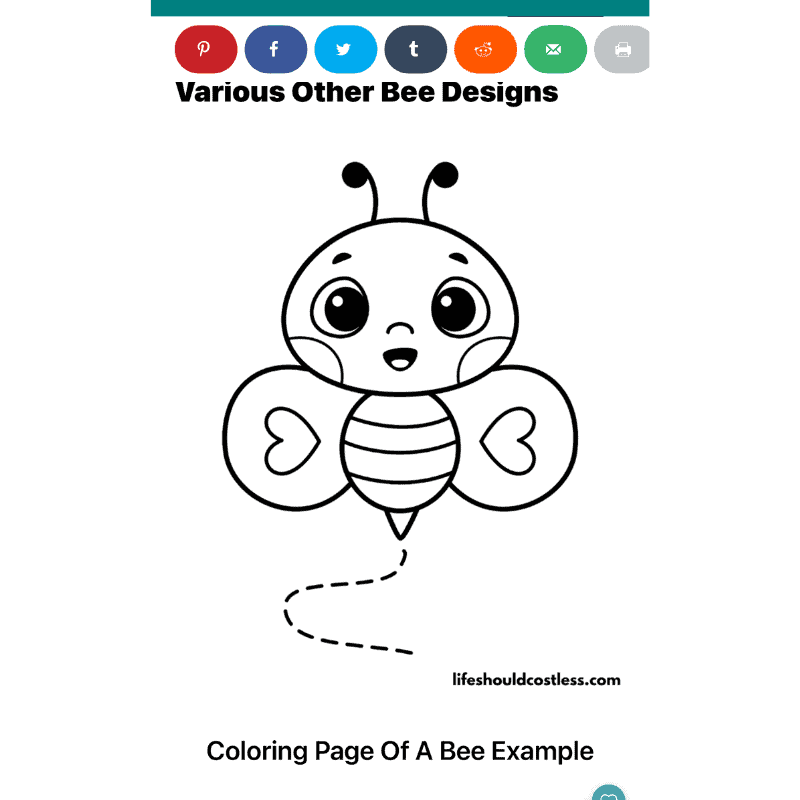 Browse the assortment of coloring sheet options and pick out the image or images you'd like to color. The provided sample image, which includes the website's watermark, provides a preview of the entire PDF's layout.
Browse the assortment of coloring sheet options and pick out the image or images you'd like to color. The provided sample image, which includes the website's watermark, provides a preview of the entire PDF's layout. -
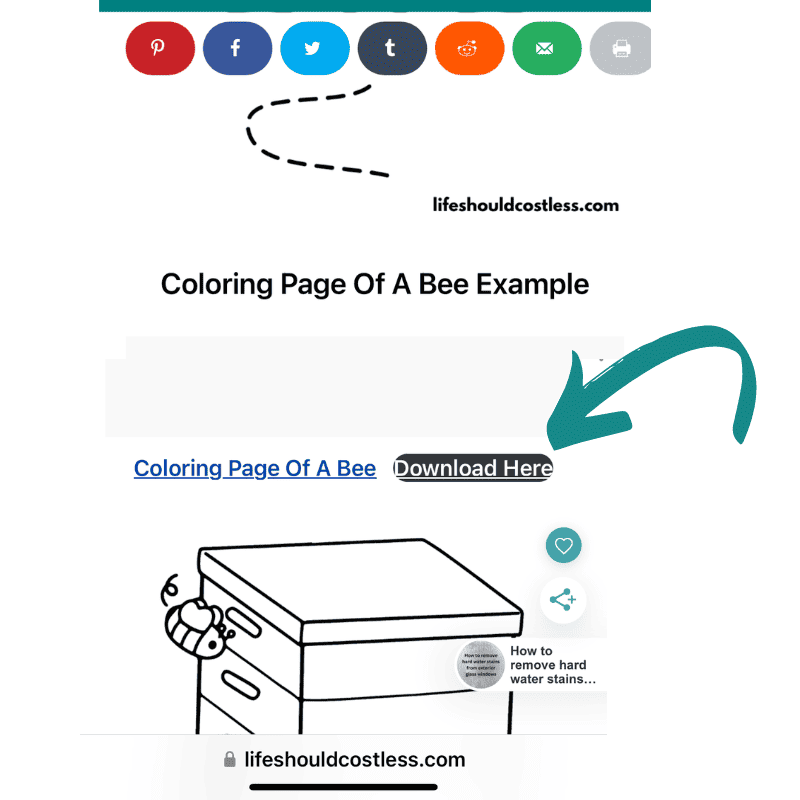 Scroll just below the desired example photo, to the PDF "download here" button.
Scroll just below the desired example photo, to the PDF "download here" button. -
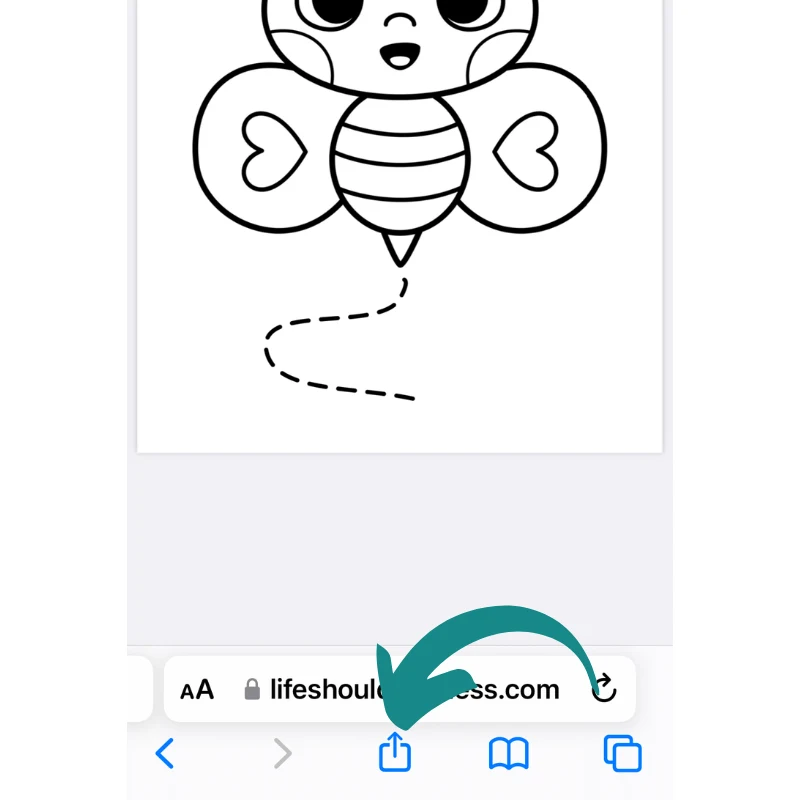
 Select download, then Select print.
Select download, then Select print. -
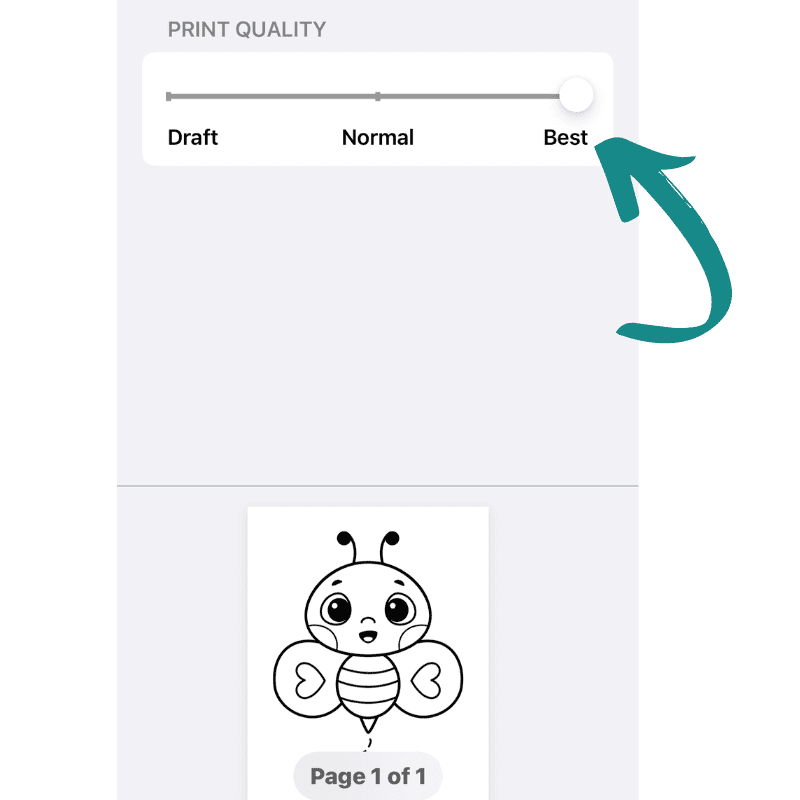 When you're ready to print, opt for the highest quality setting or the highest DPI (dots per inch) setting available. DPI refers to the density of printed dots within one inch of the printed image, and a higher number signifies superior print quality.
When you're ready to print, opt for the highest quality setting or the highest DPI (dots per inch) setting available. DPI refers to the density of printed dots within one inch of the printed image, and a higher number signifies superior print quality. -
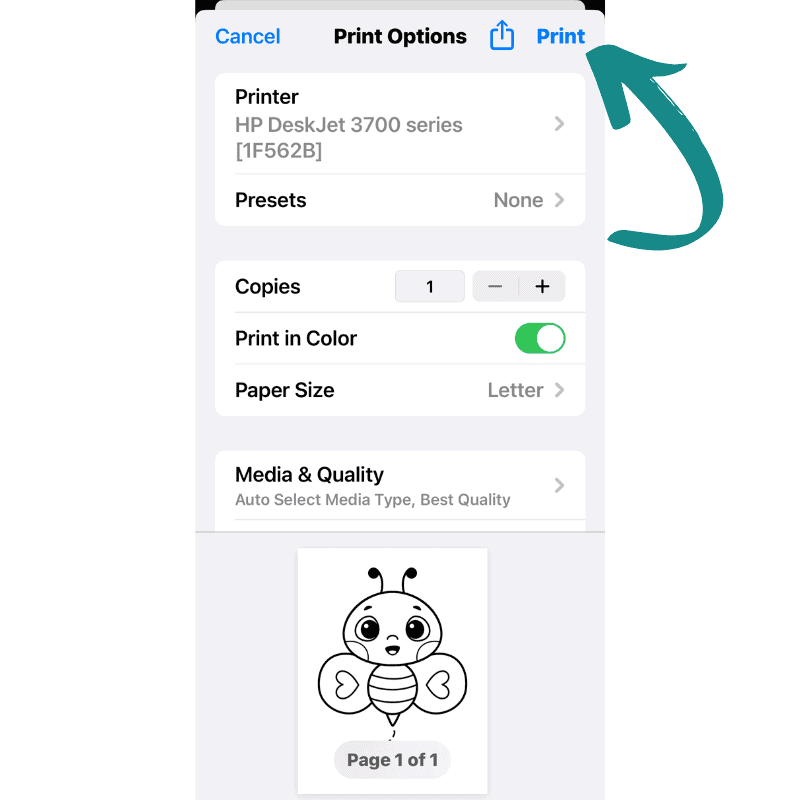 Now select "print" and send it to the desired printer.
Now select "print" and send it to the desired printer. -
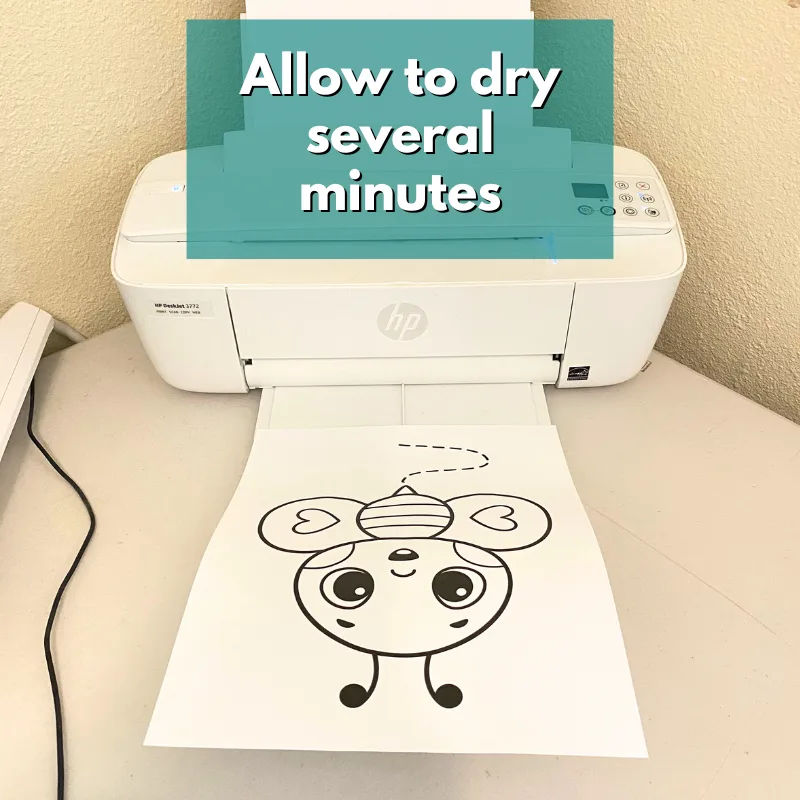 After you've completed printing your coloring image, give the ink a few minutes to set and dry. This precautionary measure will help avoid any smudging, which is particularly crucial if you intend to gift your artwork to someone
After you've completed printing your coloring image, give the ink a few minutes to set and dry. This precautionary measure will help avoid any smudging, which is particularly crucial if you intend to gift your artwork to someone -
 Prior to starting, make sure to wash your hands and dry them thoroughly. Find a clean and flat surface to lay your paper on, and then unleash your creativity as you color your prints based on your personal preferences. Once you're finished, take pleasure in the fulfillment of your efforts, with the knowledge that these creations can bring joy for years to come.
Prior to starting, make sure to wash your hands and dry them thoroughly. Find a clean and flat surface to lay your paper on, and then unleash your creativity as you color your prints based on your personal preferences. Once you're finished, take pleasure in the fulfillment of your efforts, with the knowledge that these creations can bring joy for years to come.
Notes
Ideas on what to do with these bee pictures:
You could print the coloring pages out and bind them and, paired with some nice colored pencils or an art set, it could be a fun gift for any coloring enthusiast's special event...or any day to just cheer someone up.
You could also buy some simple frames, have these designs printed out onto a quality card stock at a local printing company, color them as well as you are able, and they could easily be added to your homes decor.
These free bee coloring pictures can also be used as embroidery patterns using transfer sheets.
They could even be used as a pattern for those fine-line tattoos.
Of course, you also have the option to simply print them out and color them as often as you desire.
Please take note that this website employs an image optimizer for the sample photos, enhancing loading speed while slightly reducing quality. For the best results, we recommend downloading and utilizing the PDF file directly. The sample photo serves the purpose of providing an overall visual representation, as scrolling through a PDF can be challenging on certain devices, potentially leading to difficulty in viewing the complete image within a single screenshot.
Instructions for optimal print quality are tailored to iPhone users with an HP printer, and should be reasonably similar for other devices.
If possible, be sure to choose the "fit to page" option when printing, ensuring the entire image is included on your printed coloring sheet.
Recommended Products
Please note that I am an affiliate with Amazon.com. When you purchase through my suggested product links, the cost for you is the same but I do receive a small commission for everything in your shopping cart. Thanks so much for the support!
-
 Printworks Vanishing Embroidery Transfers, for White/Light-Colored Fabrics, 12 Sheets, Inkjet, 8.5 x 11 (00524)
Printworks Vanishing Embroidery Transfers, for White/Light-Colored Fabrics, 12 Sheets, Inkjet, 8.5 x 11 (00524) -
 eletecpro 12x16 Picture Frames Set of 5, Display 8x10 or 8.5x11 Photo Frame with Mat or 12x16 without Mat, Wall Gallery Poster Frames, Photo Frames Collage for Wall Display
eletecpro 12x16 Picture Frames Set of 5, Display 8x10 or 8.5x11 Photo Frame with Mat or 12x16 without Mat, Wall Gallery Poster Frames, Photo Frames Collage for Wall Display -
 PRINA Art Supplies 120-Color Colored Pencils Set for Adults Coloring Books with Sketchbook, Professional Vibrant Artists Pencil for Drawing Sketching Blending Shading, Quality Soft Core Oil Based
PRINA Art Supplies 120-Color Colored Pencils Set for Adults Coloring Books with Sketchbook, Professional Vibrant Artists Pencil for Drawing Sketching Blending Shading, Quality Soft Core Oil Based -
 Sacnahe Tattoo Transfer Stencil Machine Copier Printer Thermal Tattoo Kit Copier Printer With 20pcs Free Tattoo Stencil Transfer Paper Black (2023 Update Version)
Sacnahe Tattoo Transfer Stencil Machine Copier Printer Thermal Tattoo Kit Copier Printer With 20pcs Free Tattoo Stencil Transfer Paper Black (2023 Update Version) -
 Looney Zoo Temporary Tattoo Markers for Skin, 10 Body Markers + 20 Large Tattoo Stencils for Kids and Adults, Dual-End Tattoo Pens Make Bold and Fine Lines with Cosmetic-Grade Temporary Tattoo Ink
Looney Zoo Temporary Tattoo Markers for Skin, 10 Body Markers + 20 Large Tattoo Stencils for Kids and Adults, Dual-End Tattoo Pens Make Bold and Fine Lines with Cosmetic-Grade Temporary Tattoo Ink -
 U.S. Art Supply 163-Piece Mega Deluxe Art Painting, Drawing Set in Wood Box, Desk Easel - Artist Painting Pad, 2 Sketch Pads, 24 Watercolor Paint Colors, 24 Oil Pastels, 24 Colored Pencils, 60 Crayons
U.S. Art Supply 163-Piece Mega Deluxe Art Painting, Drawing Set in Wood Box, Desk Easel - Artist Painting Pad, 2 Sketch Pads, 24 Watercolor Paint Colors, 24 Oil Pastels, 24 Colored Pencils, 60 Crayons
Coloring tips
Coloring a picture of a bee can be a delightful and creative experience.
Here are some tips and tricks to help you make your bee-themed coloring pages come to life:
- Study Real Bees: Before you begin coloring, take a moment to observe real photos of bees. Pay attention to their color patterns, the textures of their bodies, and the details of their wings. This will help you replicate their natural appearance in your coloring.
- Color Variety: Bees come in various colors, from deep golden yellows to rich browns and blacks. Use a range of warm colors to capture their warmth and vibrancy. Experiment with different shades to add depth and dimension.
- Layering Techniques: Achieve depth by using layering techniques. Start with a light base color and gradually add darker shades to create shadows and highlights. Colored pencils, markers, and even watercolors can be layered to achieve stunning effects.
- Texture and Details: Pay attention to the texture of different body parts. Bees have fuzzy bodies and transparent wings. Use light, short strokes to mimic the fuzziness and consider lightly blending colors to create a more realistic texture.
- Wings and Reflections: Bees’ wings can be translucent and iridescent. Use light blues and purples for a subtle shimmer. To simulate the effect of light passing through their wings, leave some areas uncolored to represent transparency.
- Background Choices: Select a background that complements the bee. Natural scenes with flowers, leaves, or a clear blue sky can enhance the bee’s appearance. Consider using soft pastels or muted colors for the background to make the bee stand out.
- Contrasting Colors: Bees often have contrasting colors, like dark bodies with bright stripes. Use complementary colors (colors opposite each other on the color wheel) for stripes and accents to create an eye-catching contrast.
- Accents and Highlights: Add small touches of white or a lighter color to simulate reflections and give the bee a glossy look. Apply these accents sparingly on the wings, eyes, and certain body parts.
- Experiment with Mediums: Explore different coloring mediums such as colored pencils, markers, watercolors, or digital tools. Each medium offers unique opportunities for color blending and texture.
- Reference Images: Keep reference images of bees nearby while coloring. These images can serve as valuable guides for accurate color placement and details.
- Blending Tools: If using colored pencils, consider using blending tools like blending stumps, tortillons, or even a small piece of tissue paper to achieve smooth color transitions.
- Practice Patience: Coloring intricate details can be time-consuming, but the result is worth it. Take your time, bee patient ;), and enjoy the process of adding color to your bee illustration.
- Embrace Creativity: While accuracy is important, don’t be afraid to add your personal touch. Experiment with different color schemes, add imaginative patterns, or even turn your bee into a fantastical creature.
- Protect Your Artwork: If using traditional mediums, consider using fixative spray to seal and protect your colored artwork from smudging and fading.
- Share and Learn: Share your colored bee artwork with others to get feedback and learn from fellow coloring enthusiasts. Online communities and social media platforms are great places to connect and share your work.
Remember, coloring is a form of artistic expression, and there’s no right or wrong way to do it.
Have fun, be creative, and let your imagination soar as you bring your bee artwork to life!
Options For Printing:
Letter B is for bee writing practice worksheets
*My letter B is for bee coloring printable designs are crafted with the intention of being utilized within a classroom environment.
They are the exclusive printable choices on this page that do not require written authorization for usage in a public setting.
However, if asked about their source, kindly share the link to this post. Your cooperation and support is greatly appreciated!
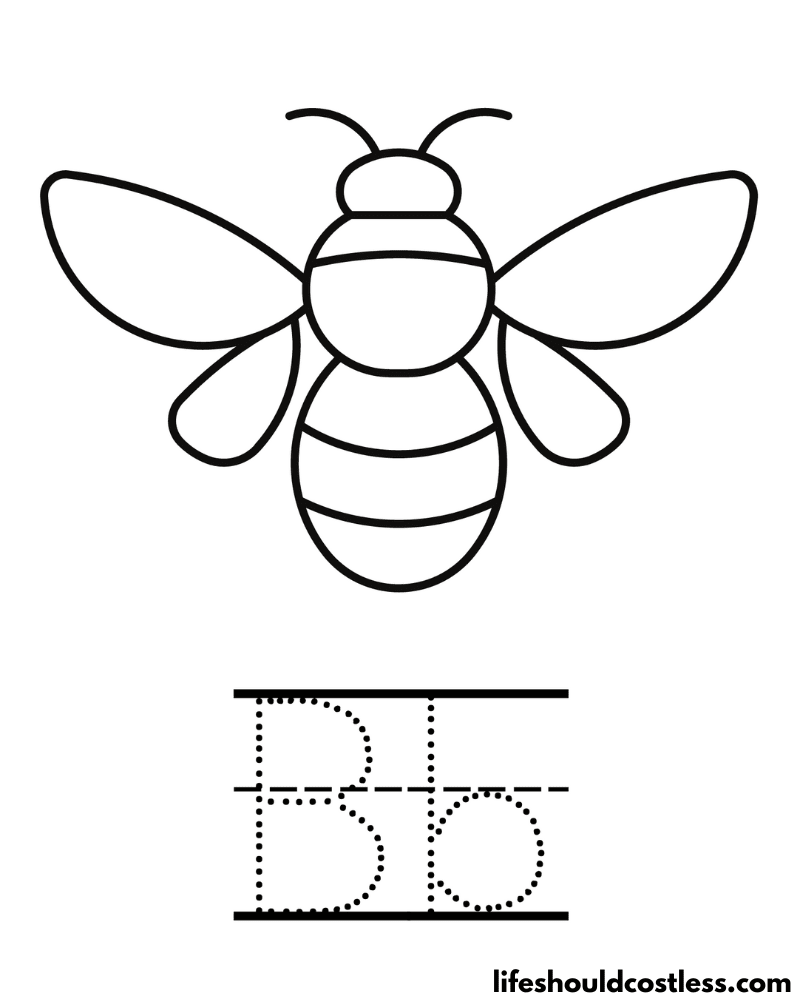
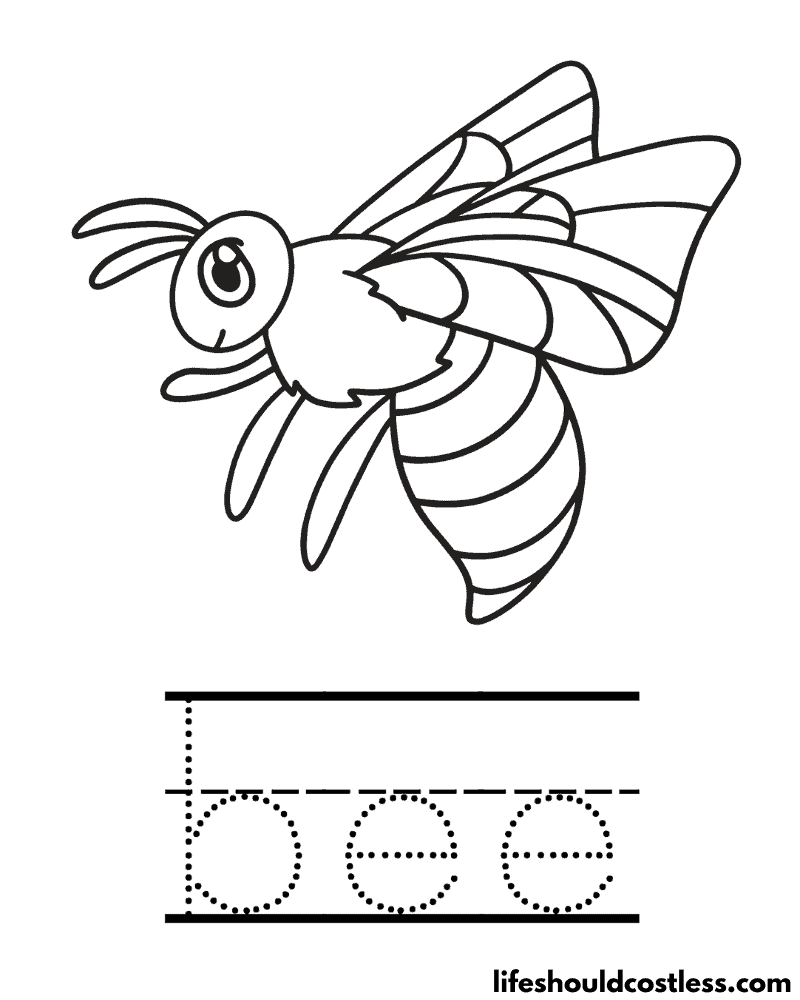
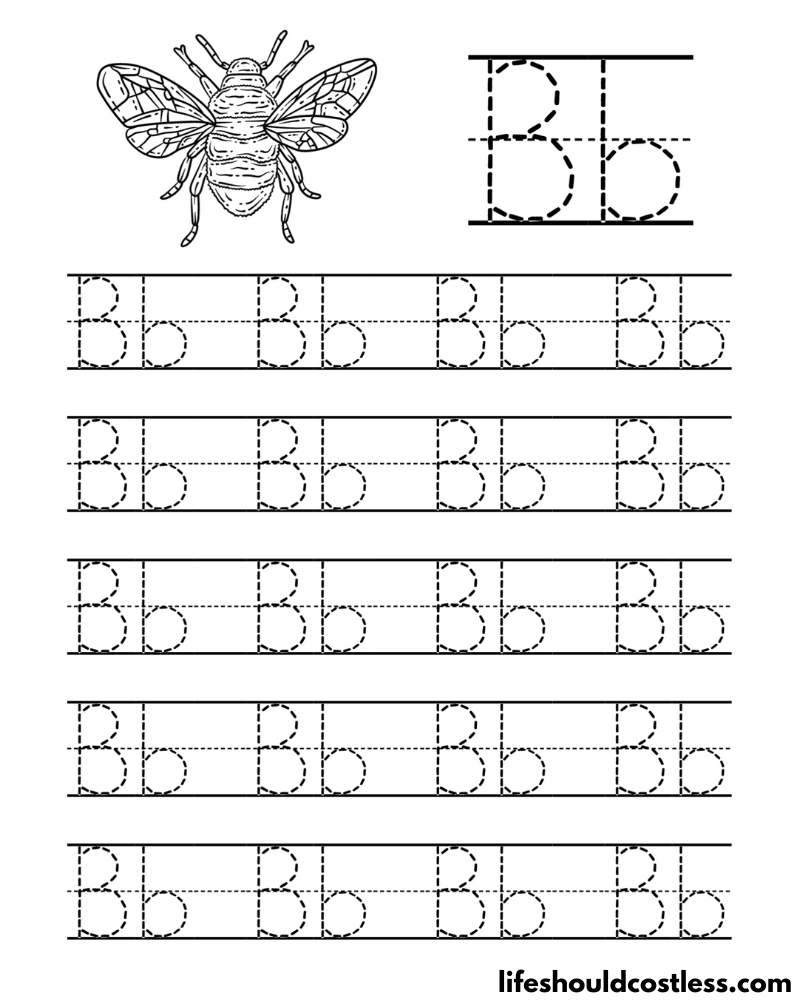
Various Other Bee Designs
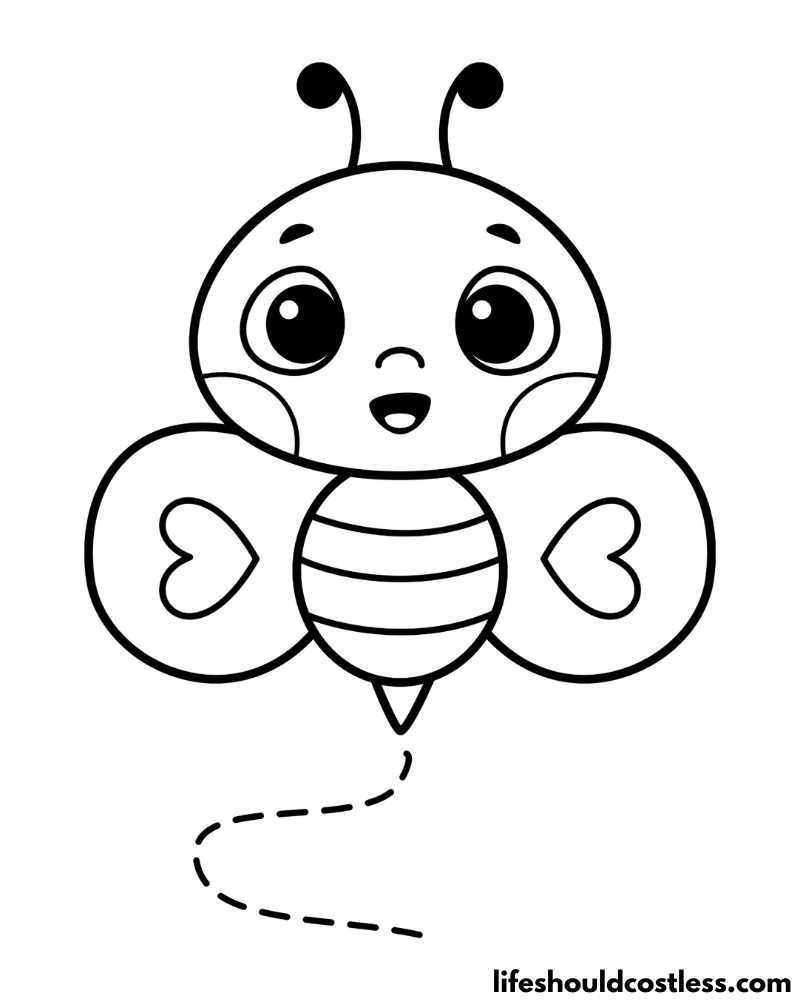
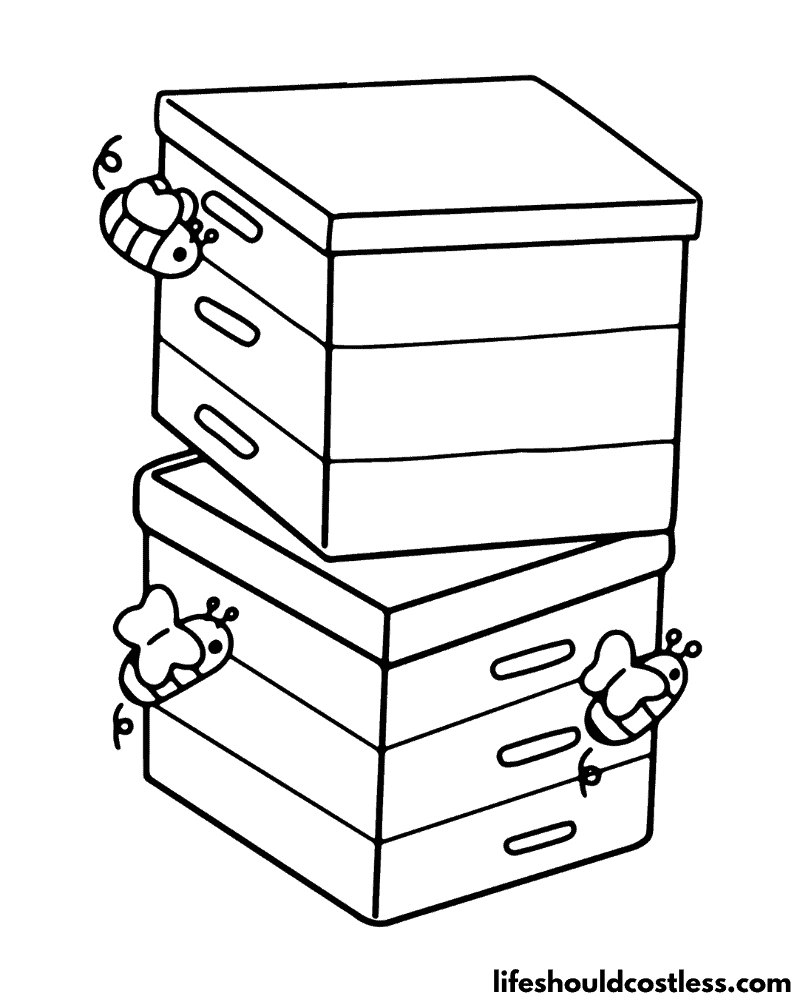
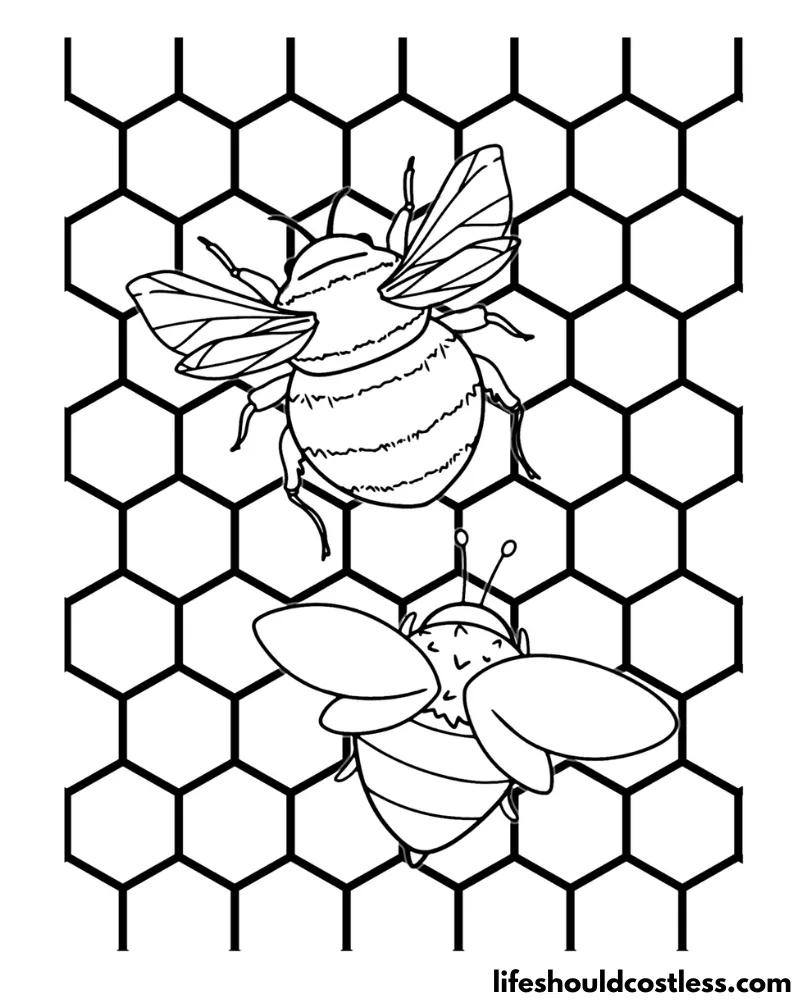

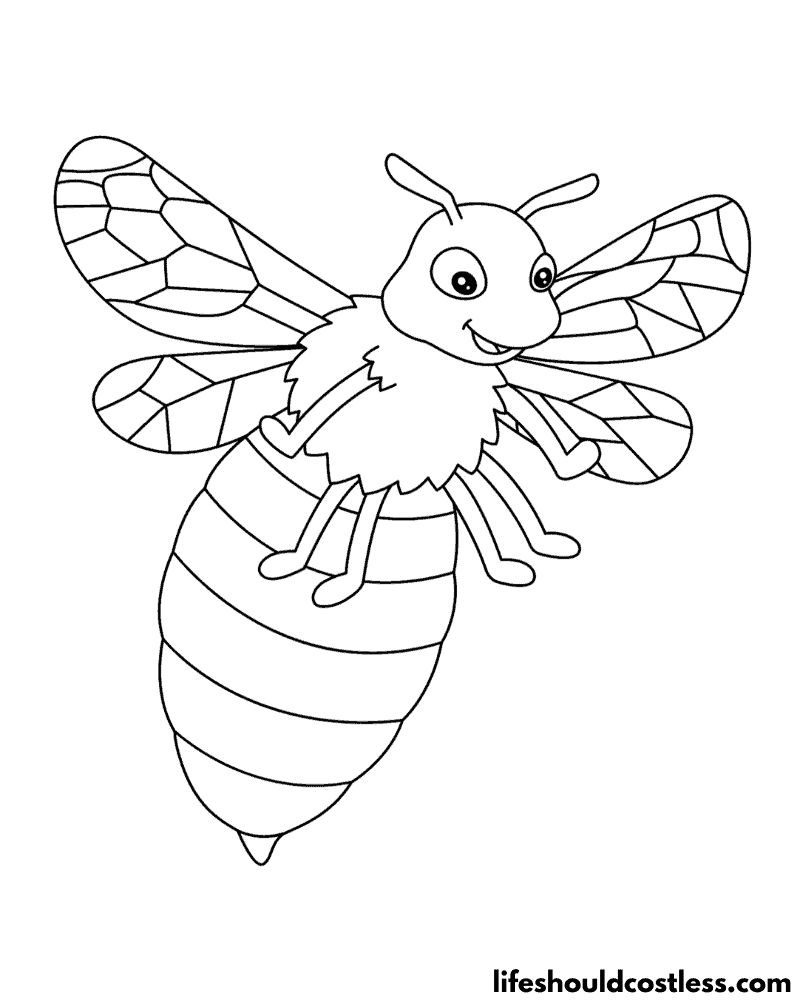
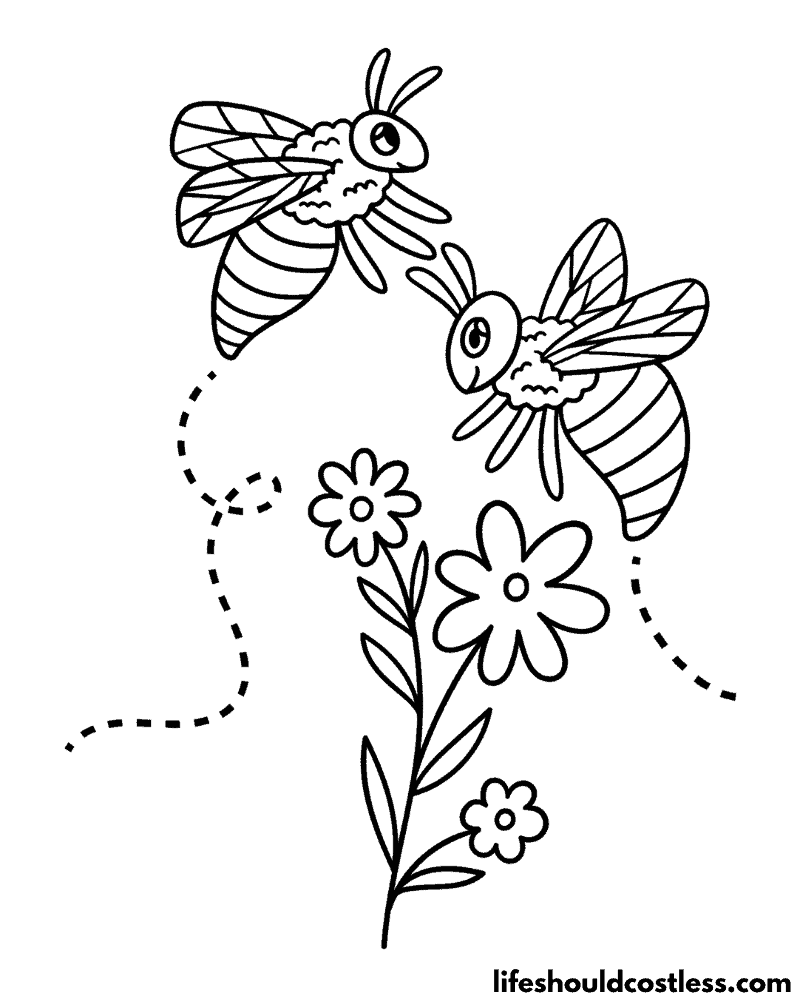
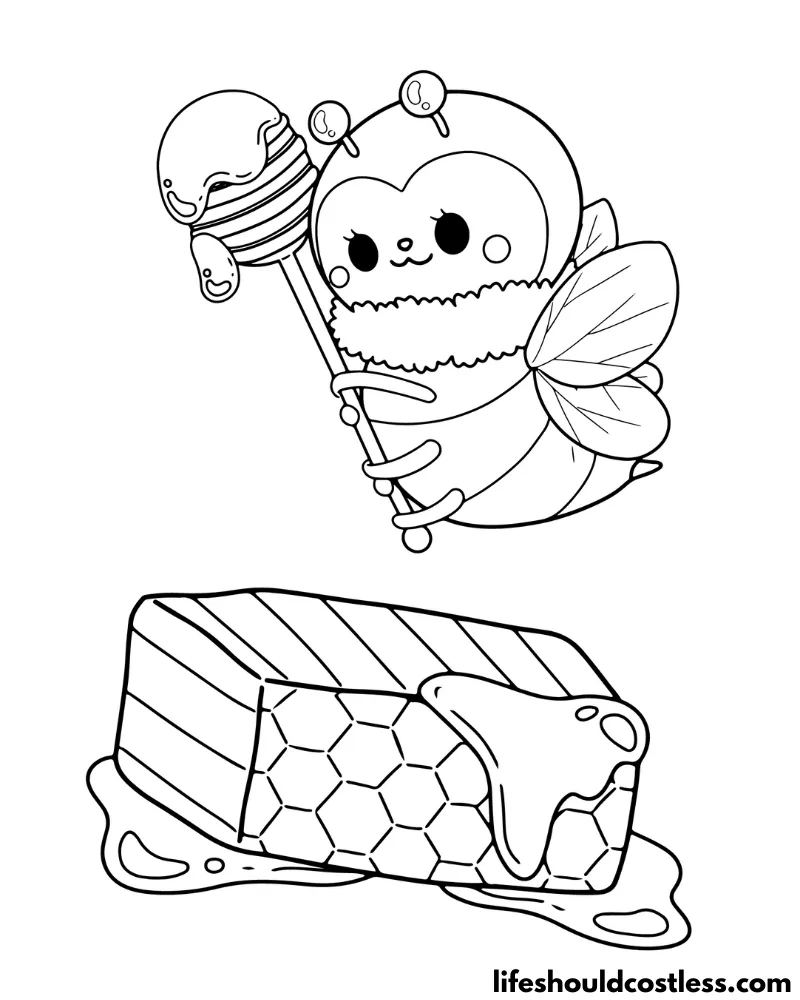
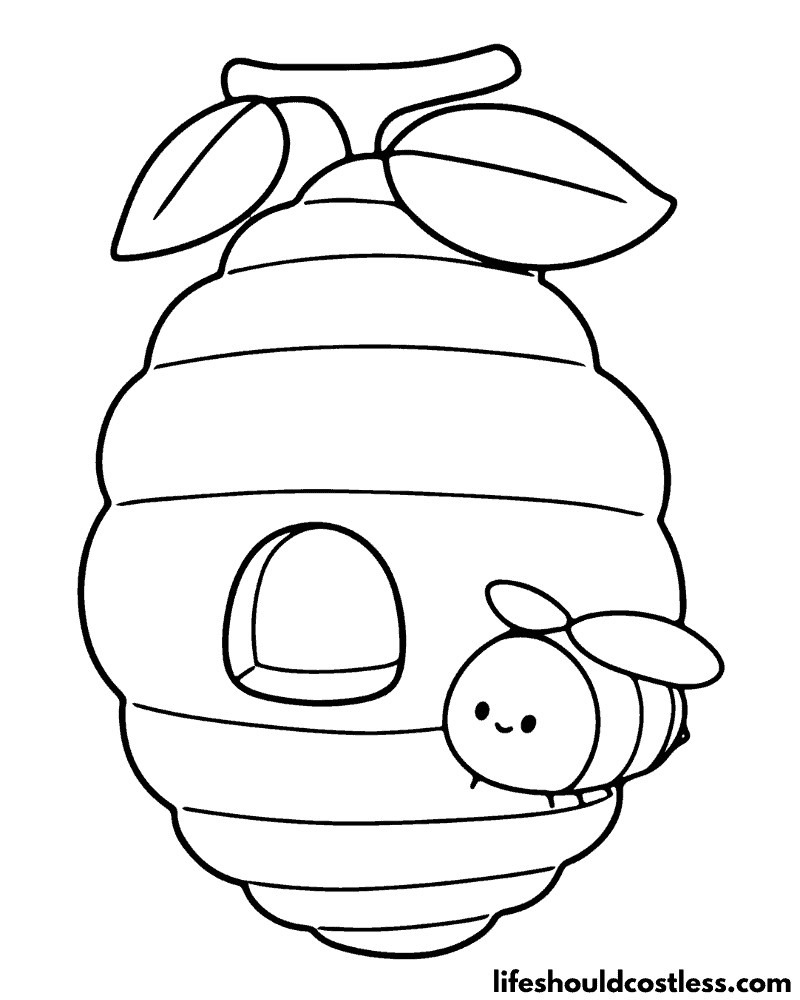

FAQ’s
Beehives can come in various colors, but the most common color used for traditional beehives is white. White beehives are popular because they reflect sunlight and help regulate the temperature inside the hive.
This is particularly important in warm climates where beehives can get quite hot in direct sunlight.
However, beehives can also be found in other colors, such as natural wood tones (from unpainted wooden hives), light pastel colors, or even more vibrant shades. Some beekeepers might choose colors based on personal preferences, aesthetics, or practical considerations.
In recent years, there has also been interest in using more environmentally friendly and non-toxic paint options for beehives to avoid any potential negative impacts on the bees.
Ultimately, while white is the most common color, the color of a beehive can vary based on different factors, including the beekeeper’s choices and the specific materials used in construction.
Bumblebees are typically recognized for their distinctive coloration, which includes a combination of black and yellow bands.
However, it’s important to note that the specific colors can vary slightly among different bumblebee species and even within individuals of the same species. Here’s a general description of the colors you might find on a bumblebee:
Black: Bumblebees typically have a base color of black. This color is prominent on the head, thorax (middle body section), and abdomen (rear body section).
Yellow: The black body of a bumblebee is adorned with alternating bands of vibrant yellow. These bands can vary in width and are often seen on the abdomen and sometimes on the thorax as well.
White and/or Orange: In addition to black and yellow, some bumblebee species may have white or orange bands instead of, or alongside, the yellow bands. These variations contribute to the diversity of bumblebee appearances.
Red: Certain bumblebee species might display red bands instead of yellow or in combination with other colors. These red bands can appear on the abdomen and thorax.
Tail Colors: The last abdominal segments, also known as the tail, can feature a variety of colors such as white, red, or orange. This is often a distinguishing feature used to identify different bumblebee species.
Variations: There are over 250 known species of bumblebees worldwide, each with its unique color patterns and combinations. Some species might have additional colors or variations, making them visually distinct.
Fur and Texture: Bumblebees also have a fuzzy texture due to the hair-like structures covering their bodies. These hairs can give the bee a slightly different appearance, as they catch and reflect light.
It’s important to consult reliable resources or field guides specific to your region if you’re interested in identifying the bumblebee species native to your area and their precise coloration.
Overall, the black and yellow coloration of bumblebees serves as a visual warning to predators, indicating their potential sting and making them a recognizable and important part of many ecosystems.
*I will add more bee colour / color questions and answers as the questions get sent to me.
Conclusion
In conclusion, exploring the world of bee coloring pages offers more than just an artistic endeavor; it’s a journey into the captivating world of these busy little pollinators.
As we’ve delved into the details of bee anatomy, behaviors, and their vital role in ecosystems, it’s evident that these coloring pages provide an opportunity for both education and relaxation.
Whether you’re a curious learner eager to understand the intricate dance of bee communication or an artist seeking to capture the essence of these buzzing wonders, our bee coloring sheets offer a canvas for creativity and discovery.
By adding hues to these illustrations, we not only celebrate the beauty of nature but also foster a deeper appreciation for the bees that contribute so significantly to our world.
So pick up your favorite coloring tools and embark on a journey of color, knowledge, and inspiration with our collection of bee designs – where art, education, and nature intertwine in the most delightful way.
Thanks so much for stopping by my blog and supporting my endeavors to make people’s lives a little easier/better/more affordable.
If you liked this post, or found it helpful in any way, please make sure to share it with your family, friends, and co-workers via social media.
Or you could even send them the direct link via email. Whichever way you choose to spread the love, I super appreciate it! ~Sarah
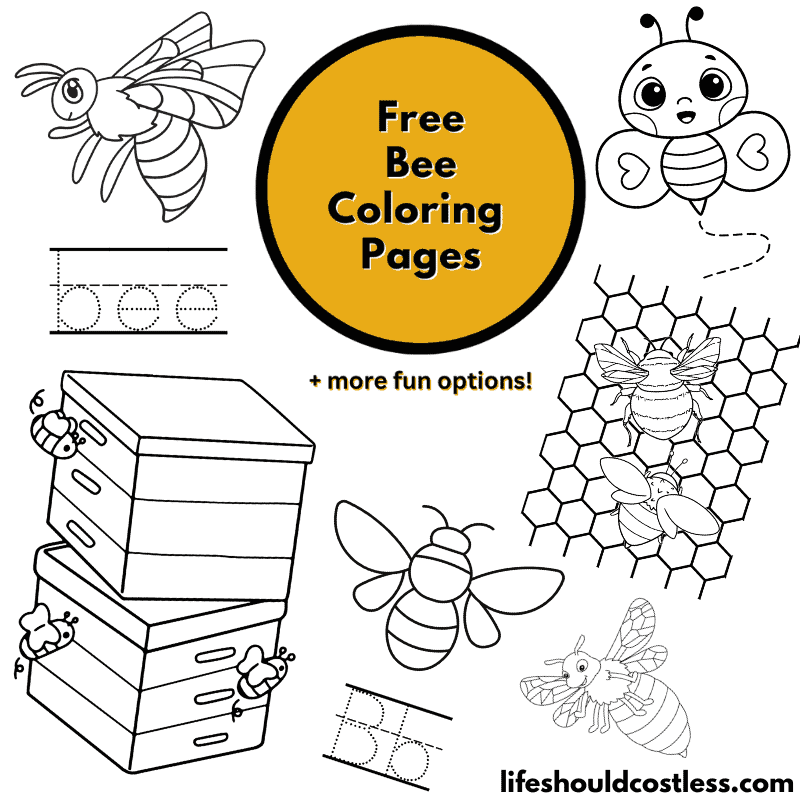
How To Follow & Support This Site
- If you would like to subscribe to my email list, go here.
- Make sure to follow along via social media, by going here.
- If you would like to learn how to really show your support to this site (at no cost to you), go here.
- If you would like to make a direct donation to the site, go here.
Check out my other free printables
- To see all of my free printables, go here.
- If you would like to see my index of free printable coloring pages, go here!
- To see all of my animal coloring pages, go here.
- To see all of my insect-related coloring pages, go here.
Otherwise, here are direct links to several of my other related posts that you’re also going to love:
Animals / Insects
Animals / Birds
Animals / Mammals
Other good resources for a printable bee
- https://www.dreamstime.com/illustration/bee-coloring.html
- https://www.buzzaboutbees.net/bee-coloring-pages.html
- https://www.thecolor.com/coloring/bees.aspx
*This post was originally shared to this blog on 08/21/2023, and has since been updated to improve user experience, add video instruction, as well as to make it as shareable as possible across the social medias.
**Please note that I do try my hardest to provide factual, but easy to understand, information about each topic. If you notice a discrepancy in my coloring pages, facts, or see something that you deem “misinformation/incorrect” please make sure to notify me about it. I would prefer that you send me an email with a link to a more reputable resource on that subject, so that I can correct it as soon as possible. Thanks so much for helping this site become the best that it can be!
***Resources from djinkers were used in the production of this article.
